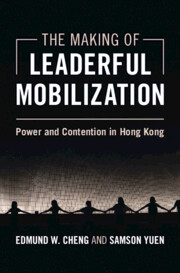Book contents
- Reviews
- The Making of Leaderful Mobilization
- Cambridge Studies in Contentious Politics
- The Making of Leaderful Mobilization
- Copyright page
- Dedication
- Contents
- Figures
- Tables
- Preface
- Acknowledgements
- Notes on Transliteration
- Abbreviations
- 1 Introduction
- Part I Context
- Part II Episodes
- 4 No Leaders, Only the Masses
- 5 Synchronizing Threats
- Part III Mechanisms
- Appendices
- References
- Index
5 - Synchronizing Threats
from Part II - Episodes
Published online by Cambridge University Press: 30 January 2025
- Reviews
- The Making of Leaderful Mobilization
- Cambridge Studies in Contentious Politics
- The Making of Leaderful Mobilization
- Copyright page
- Dedication
- Contents
- Figures
- Tables
- Preface
- Acknowledgements
- Notes on Transliteration
- Abbreviations
- 1 Introduction
- Part I Context
- Part II Episodes
- 4 No Leaders, Only the Masses
- 5 Synchronizing Threats
- Part III Mechanisms
- Appendices
- References
- Index
Summary
Chapter 5 elucidates how the Anti-Extradition Movement erupted despite the lack of political opportunities in the post-Umbrella period. We demonstrate how abeyance networks from previous mobilizations and an online petition campaign transformed the idea of extradition into a widely perceived existential threat, galvanizing popular support for the movement and leading to the confluence of the masses.
Keywords
- Type
- Chapter
- Information
- The Making of Leaderful MobilizationPower and Contention in Hong Kong, pp. 112 - 134Publisher: Cambridge University PressPrint publication year: 2025

